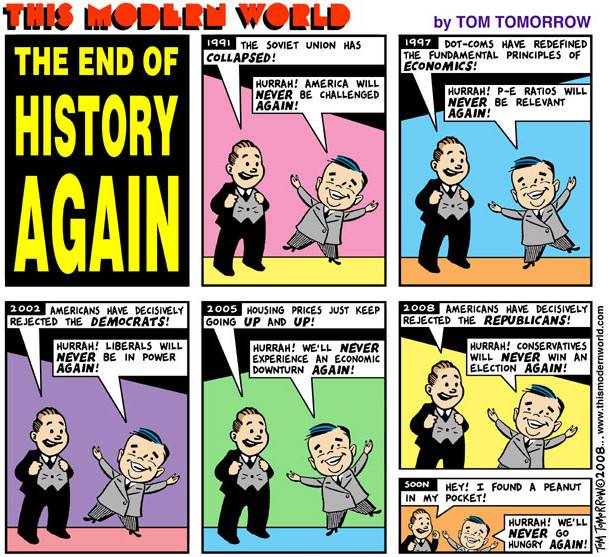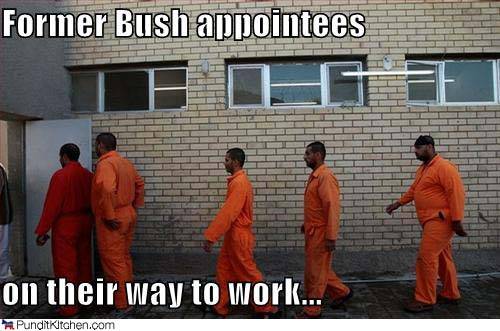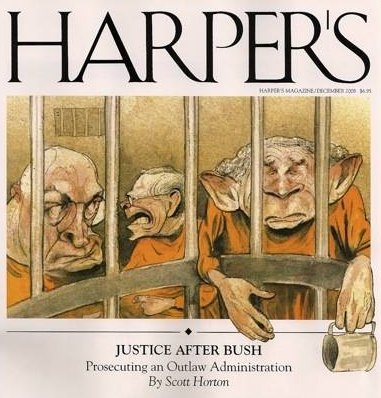
Friday, November 21, 2008
Buster Keaton's The General
Yeah, it's silent. So what? You'll barely notice. It's that good.
By Gary Giddins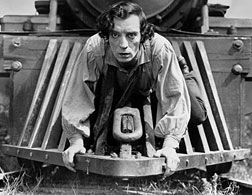 Those of us who grew up in the 1950s and 1960s, when television was awash in classic movies (Million-Dollar Movie, Shock Theater, The Late Show, and Silents Please were among the first schools in cinema—just ask Scorsese, Spielberg, or Coppola), are aghast to find that our children are often reluctant to watch black-and-white films, let alone silent ones. Especially those deemed to be among the greatest ever made. The imprimatur of the experts turns pleasure into obligation, and suddenly the notion of sitting through a comedy that had for decades convulsed audiences takes on all the promise of reading The Merry Wives of Windsor—the most annoying and witless of Shakespeare's plays, yet once upon a time thought to be a riot.
Those of us who grew up in the 1950s and 1960s, when television was awash in classic movies (Million-Dollar Movie, Shock Theater, The Late Show, and Silents Please were among the first schools in cinema—just ask Scorsese, Spielberg, or Coppola), are aghast to find that our children are often reluctant to watch black-and-white films, let alone silent ones. Especially those deemed to be among the greatest ever made. The imprimatur of the experts turns pleasure into obligation, and suddenly the notion of sitting through a comedy that had for decades convulsed audiences takes on all the promise of reading The Merry Wives of Windsor—the most annoying and witless of Shakespeare's plays, yet once upon a time thought to be a riot.
Still, for anyone who has never seen a silent picture or, worse, seen only speeded-up pie-throwing excerpts, Kino International has an offer you can't refuse: a spotless new transfer of Buster Keaton's 1926 epic, The General. Kino initially released a DVD of The General in 1999, which looks like every other version I've seen in theaters or at home—the focus is soft, and the tinted film stock is faded, scratched, and jumpy. The new edition, part of a two-disc set (most of the extras concern the historical basis for the story), is pristine, sharply focused, stable, and gorgeous.
Gorgeous is important, because The General is a peephole into history and by any definition an uncannily beautiful film. Indeed, for a first-time viewer, I would emphasize the beauty over the comedy. Many people are disappointed when they first see The General because they have heard that it is one of the funniest movies ever made. It isn't. Keaton made many films that are tours de force of hilarity, including Sherlock Jr., The Navigator, and Seven Chances (all available from Kino). The General is something else, a historical parody set during the Civil War.
The comedy is rich but deliberate and insinuating. It aims not to split your sides but rather to elicit and sustain—for 78 minutes—a smile and sense of wonder, interrupted by several perfectly timed guffaws. The General belongs to at least three movie genres: comedy, historical, and chase. Most of it is constructed around a pursuit as relentless as any Bourne blowout, involving a Confederate locomotive, called the General, hijacked by Union spies.
The General's engineer, Johnny Grey (Keaton), spends the first half racing after it—on foot, handcar, bicycle, and another train—and, once he has stolen it back, the second half in flight from the Texas, a train manned by Union troops. If the film begins as a contest between man and machine, it ultimately depicts a triumphant collusion between the two. Keaton, one of the greatest natural athletes and stuntmen in film, loves his train as much as he does his inamorata, Annabelle Lee (played by the wonderfully oblivious Marion Mack*). He leaps and crawls over every inch of it, from the pilot, or cowcatcher, riding low on the tracks to the tender carrying the fuel.
In Keaton's hands, the train is nothing more than a gigantic prop, an incessant inspiration to his inventive genius. Many passages are so suspenseful and minutely worked out that the gag, when it comes, is like the release of the General's steam. It gives you a chance to breathe again.
Giant ice penis - is climate change to blame?
If there was any doubt about the terrible threat that global warming poses to humanity, then it can now be dismissed - as this shocking photograph proves that climate change is turning icebergs into giant penises.

The cockberg was photographed by Andy Rouse* in the Bransfield Strait near Antarctica.
Experts now believe** that it is only a matter of time before an armada of penis-shaped chunks begin to break off the Antarctic ice floes, and then roam the oceans wreaking havoc and luring sailors to their doom.
Flunking the Electoral College
On Dec. 15, the United States will endure a quadrennial ritual born in the economics and politics of slavery and the quill-pen era. Members of the Electoral College are scheduled to meet in each of the 50 states and the District of Columbia to formally choose the next president.There is no real doubt about how the electors will vote, but it is disturbing that they have any role at all in making this vital choice in the 21st century. The Electoral College is more than just an antiquated institution: it actively disenfranchises voters and occasionally (think 2000) makes the candidate with fewer popular votes president. American democracy would be far stronger without it.
There is no reason to feel sentimental about the Electoral College. One of the main reasons the founders created it was slavery. The southern states liked the fact that their slaves, who would be excluded from a direct vote, would be counted — as three-fifths of a white person — when Electoral College votes were apportioned.
The founders also were concerned, in the day of the wooden printing press, that voters would not have enough information to choose among presidential candidates. It was believed that it would be easier for them to vote for local officials, whom they knew more about, to be electors. It is hard to imagine that significant numbers of voters thought they did not know enough about Barack Obama and John McCain by Election Day this year.
And, while these reasons for the Electoral College have lost all relevance, its disadvantages loom ever larger. To start, the system excludes many voters from a meaningful role in presidential elections. If you live in New York or Texas, for example, it is generally a foregone conclusion which party will win your state's electoral votes, so your vote has less meaning — and it can feel especially meaningless if you vote on the losing side. On the other hand, if you live in Florida or Ohio, where the outcome is less clear, your vote has a greatly magnified importance.
http://www.nytimes.com/2008/11/20/opinion/20thu1.html?_r=1&th&emc=th
2025: the end of US dominance
European Union will be 'hobbled giant' by 2025
Triumph of western democracy not certain
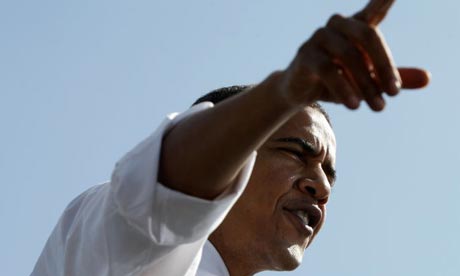 The United States' leading intelligence organisation has warned that the world is entering an increasingly unstable and unpredictable period in which the advance of western-style democracy is no longer assured, and some states are in danger of being "taken over and run by criminal networks".
The United States' leading intelligence organisation has warned that the world is entering an increasingly unstable and unpredictable period in which the advance of western-style democracy is no longer assured, and some states are in danger of being "taken over and run by criminal networks".The global trends review, produced by the National Intelligence Council (NIC) every four years, represents sobering reading in Barack Obama's intray as he prepares to take office in January. The country he inherits, the report warns, will no longer be able to "call the shots" alone, as its power over an increasingly multipolar world begins to wane.
Looking ahead to 2025, the NIC (which coordinates analysis from all the US intelligence agencies), foresees a fragmented world, where conflict over scarce resources is on the rise, poorly contained by "ramshackle" international institutions, while nuclear proliferation, particularly in the Middle East, and even nuclear conflict grow more likely.
"Global Trends 2025: A World Transformed" warns that the spread of western democratic capitalism cannot be taken for granted, as it was by George Bush and America's neoconservatives.
"No single outcome seems preordained: the Western model of economic liberalism, democracy and secularism, for example, which many assumed to be inevitable, may lose its lustre – at least in the medium term," the report warns.
It adds: "Today wealth is moving not just from West to East but is concentrating more under state control," giving the examples of China and Russia.
"In the wake of the 2008 global financial crisis, the state's role in the economy may be gaining more appeal throughout the world."
At the same time, the US will become "less dominant" in the world – no longer the unrivalled superpower it has been since the end of the Cold War, but a "first among equals" in a more fluid and evenly balanced world, making the unilateralism of the Bush era no longer tenable.
http://www.guardian.co.uk/world/2008/nov/20/barack-obama-president-intelligence-agency
Giant rabbits

Deflation - what's not to like?
The big worry these days is the possibility of deflation. At first glance, deflation might sound like good news, so let's stop at first glance. In times of deflation, your money will increase in value as it sits in your pocket. Hooray! Prices will fall. In fact, prices will fall so sharply that you won't know whether to buy an incredibly cheap thing or wait until it gets even cheaper. Deflation: what's not to like?
Deflation is only a problem if you're the one trying to sell the cheap thing, or if the incredibly cheap thing is your salary, and your boss can't decide between paying you peanuts and finding someone else who will do your job for even less. In these circumstances investment becomes a little bit pointless, and growth halts, and a deflationary spiral ensues leading - allegedly - to long-term depression.
That's a bridge best crossed when we come to it. For now, all you need to know is that prices are falling, and will fall further, and so will interest rates, and that compared with this time next year, you are living in a relative economic paradise. Enjoy it while you can.
http://www.guardian.co.uk/business/2008/nov/19/recession-inflation
This time, Silicon Valley's technology changed U.S. politics
by Mike Cassidy
It struck me as I sat at the computer in the kitchen the night of Nov. 4, with the TV blaring election results in the background.
I was doing my best John-King-on-CNN imitation, showing my kids a Web-based electoral map while trying to explain why 270 votes was the magic number.
And you know what it was that struck me? That the TV was in the background.
This presidential election was different. Different in profound and poignant ways, yes. But different in mundane ways, too - ways not marked by a milestone or a moment, but rather by the evolution of how we find out what we want to know.
This election and the way we followed it and fought about it had everything to do with what has happened in Silicon Valley in the past decade. The Internet, social networking, blogging, the mobile phone as laptop.
I know. It's way too late to declare the 2008 presidential contest as the first election of the Internet age. But at our house, and I imagine at houses across America, the Internet for the first time became a nearly seamless part of our election experience.
There is more coming, no doubt. By 2012, we'll barely recognize the ways we gobbled up the late-breaking results this year from Ohio and New Mexico while trying to divine the winner in North Carolina by clicking on piles of exit poll data.
Consider how odd it was this Election Day to have CNN's Wolf Blitzer actually tell viewers to take their eyes off him and his coverage and instead feast their eyes on the CNN.com Web site.
By 2012, the television and computer monitor will be one. One big screen. Click on Wolf for his words and wisdom. Click on a corner icon to bring up CNN.com.
http://www.popmatters.com/pm/article/65909-this-time-silicon-valleys-technology-changed-us-politics/
EPA Moves to Ease Air Rules for Parks
Regional Administrators Decry Decision

The Environmental Protection Agency is finalizing new air-quality rules that would make it easier to build coal-fired power plants, oil refineries and other major polluters near national parks and wilderness areas, even though half of the EPA's 10 regional administrators formally dissented from the decision and four others criticized the move in writing.
Documents obtained by The Washington Post show that the administration's push to weaken Clean Air Act protections for "Class 1 areas" nationwide has sparked fierce resistance from senior agency officials. All but two of the regional administrators objecting to the proposed rule are political appointees.
The proposal would change the practice of measuring pollution levels near national parks, which is currently done over three-hour and 24-hour increments to capture emission spikes during periods of peak energy demand; instead, the levels would be averaged over a year. Under this system, spikes in pollution would no longer violate the law.
In written submissions, EPA regional administrators have argued that this switch would undermine critical air-quality protections for parks such as Virginia's Shenandoah, which is frequently plagued by smog and poor visibility.
EPA Region 4 Administrator J. I. Palmer Jr., whose office oversees the Southeast, wrote that the new formula "would reduce consistency, accuracy and public review" and "could allow greater deterioration of air quality in clean areas rather than preventing significant deterioration."
Midnight Hour

When President Jimmy Carter lost his bid for reëlection, in November, 1980, he had lots of unfinished business that he did not intend to leave that way. Carter's Administration spent the next several weeks generating regulations at an unprecedented rate, until, in its last month in office, it published more than ten thousand pages of new rules. These rules, which, like most issued by federal agencies, needed no congressional approval, touched on everything from crash tests for cars to access to medical records, and a phrase was coined to describe them. They became known as "midnight regulations," after the "midnight judges" appointed by John Adams in the final hours of his Presidency.
Since Jimmy Carter, every President has complained about midnight regulations and, four or eight years later, every President has issued them. On a percentage basis, George Bush senior holds the record: his Administration issued a greater proportion of its rules during the midnight period—generally defined as the last three months in office—than any other President's. In absolute terms, though, Bill Clinton takes the gold: his Administration, during its midnight phase, published more than twenty-six thousand pages' worth of rules in the Federal Register. (According to the National Journal, by the time Clinton left office "the journalists who cover the White House had thrown up their hands at the prospect of keeping up.") President George W. Bush used the timing of these regulations as a rationale for suspending many of them. "I told people pretty plainly that I was going to review all the last-minute decisions that my predecessor had made, and that is exactly what we're doing," he declared.
Now, of course, Bush has entered into his own midnight period, and it promises to be a dark time indeed. Among the many new regulations—or, rather, deregulations—the Administration has proposed are rules that would: make it harder for the government to limit workers' exposure to toxins, eliminate environmental review from decisions affecting fisheries, and ease restrictions on companies that blow up mountains to get at the coal underneath them. Other midnight regulations in the works include rules to allow "factory farms" to ignore the Clean Water Act, rules making it tougher for employees to take family or medical leave, and rules that would effectively gut the Endangered Species Act. Most regulations are subject to public input; such is the sense of urgency that the Administration has brought to the task of despoliation that the Interior Department completed its "review" of two hundred thousand public comments on the endangered-species rules in just four days, a feat that, one congressional aide calculated, required each staff member involved to read through comments at the rate of seven per minute. "So little time, so much damage" is how the Times recently put it.
http://www.newyorker.com/talk/comment/2008/11/24/081124taco_talk_kolbert
A Media Parable for "the Center"
by Norman Solomon

Barack Obama and Bill Clinton exit Clinton's office in Harlem after a lunch meeting. The myth of the former president's "lurch to the left" may tinge the media's view of the president-elect's early days in office. (Photo: Mario Tama / Getty Images)
It's been 16 years since a Democrat moved into the White House. Now, the fog of memory and the spin of media are teaming up to explain that Barack Obama must hew to "the center" if he knows what's good for his presidency.
"Many political observers," The San Francisco Chronicle reported days ago, say that Obama "must tack toward the political mainstream to avoid miscalculations made by President Bill Clinton, who veered left and fired up the 1994 Republican backlash." This storyline provides a kind of political morality play: The new president tried to govern from the left, and Democrats lost control of Congress just two years later.
But, if facts matter, the narrative is a real head-scratcher.
During the 1992 election year, Clinton had campaigned for the White House under the mantra "Putting People First." But as economic analyst Doug Henwood was to comment, President-elect Clinton swiftly morphed into the champion of an austerity plan that could have been called "Putting Bondholders First."
From the outset, President Clinton made clear his commitments to the corporate centers of economic power by choosing such officials as Treasury Secretary Lloyd Bentsen, Commerce Secretary Ron Brown, trade representative Mickey Kantor and Secretary of State Warren Christopher.
Soon after becoming president, Clinton abandoned his few initial stances that might qualify as "left." He quickly deserted his brief position for gay rights in the military. Under fire for his nomination of progressive law professor Lani Guinier to be assistant attorney general for civil rights, Clinton tossed her overboard.
In sharp contrast, the new president fought like hell for the corporate-beloved trade agreement known as NAFTA. And he spread his wings as a deficit hawk, while his campaign's pledges of "public investment" fell to earth with paltry line items. Less than five months into his presidency, Newsweek lauded Clinton's "shift to the right" and urged him to show "the backbone" to stay there.
But none of that has stopped the media's clucking about the Clinton administration's early "lurch to the left." The myth never died, though it was quickly ripe for debunking.
A Sea of Unwanted Imports
And for the first time, Mercedes-Benz, Toyota, and Nissan have each asked to lease space from the port for these orphan vehicles. They are turning dozens of acres of the nation's second-largest container port into a parking lot, creating a vivid picture of a paralyzed auto business and an economy in peril.
http://www.nytimes.com/2008/11/19/business/economy/19ports.html?_r=2&hp&oref=slogin
Blog Archive
- ► 2009 (3416)
-
▼
2008
(2217)
-
▼
November
(225)
-
▼
Nov 21
(15)
- Justice After Bush
- Buster Keaton's The General
- Giant ice penis - is climate change to blame?
- Flunking the Electoral College
- 2025: the end of US dominance
- Giant rabbits
- Deflation - what's not to like?
- This time, Silicon Valley's technology changed U.S...
- Get Your War On: New World Order
- EPA Moves to Ease Air Rules for Parks
- Midnight Hour
- The end of history again
- A Media Parable for "the Center"
- A Sea of Unwanted Imports
- Former Bush appointees on their way to work
-
▼
Nov 21
(15)
-
▼
November
(225)


